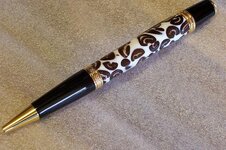McBryde
Member
When I am inserting the parts into my finished blanks I am getting small cracks forming from the pressure outward. Is there anything that can be done to discourage cracking? I am doing slimlines and am using a 7mm bit to drill them. Should I go to the drill bit that is a little larger to discourage this, or will that even help? I'm sure others have had this problem, any solutions would help.
Thanks,
Emerson
Thanks,
Emerson

